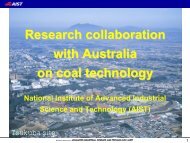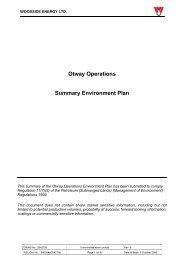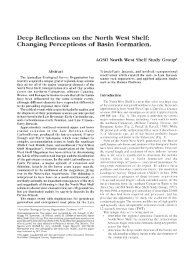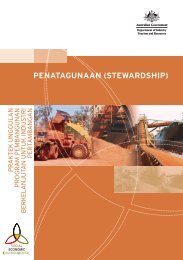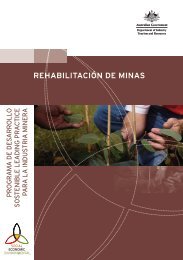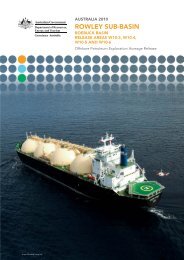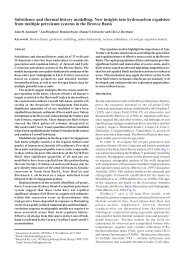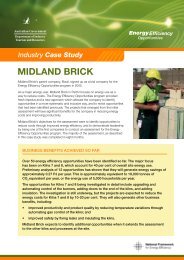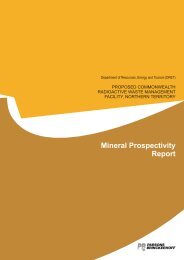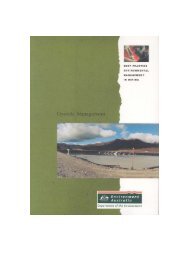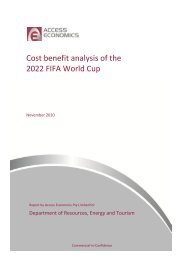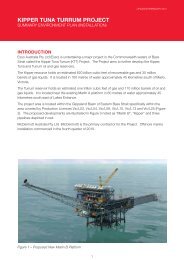A guide to leading practice sustainable development in mining
A guide to leading practice sustainable development in mining
A guide to leading practice sustainable development in mining
You also want an ePaper? Increase the reach of your titles
YUMPU automatically turns print PDFs into web optimized ePapers that Google loves.
Such richness also br<strong>in</strong>gs challenges. A key impediment for manag<strong>in</strong>g biodiversity is<br />
the limited taxonomic coverage <strong>to</strong> date, with estimates that only one <strong>in</strong> four species<br />
<strong>in</strong> Australia is known (PMSEIC 2005). For the m<strong>in</strong>erals <strong>in</strong>dustry this represents<br />
significant uncerta<strong>in</strong>ty <strong>in</strong> pre-m<strong>in</strong><strong>in</strong>g biodiversity assessment particularly <strong>in</strong><br />
biodiverse regions.<br />
There is a grow<strong>in</strong>g recognition of the critical role that bus<strong>in</strong>ess can play (<strong>in</strong> partnership<br />
with governments, the community and researchers) <strong>to</strong> change the threats <strong>to</strong><br />
biodiversity <strong>in</strong><strong>to</strong> opportunities. Through these strategic partnerships impacts that have<br />
taken place over the last 200 years due <strong>to</strong> <strong>in</strong>creas<strong>in</strong>g land clear<strong>in</strong>g, un<strong>susta<strong>in</strong>able</strong> land<br />
management <strong>practice</strong>s, <strong>in</strong>troduced species and fragmentation of the landscape can<br />
be unders<strong>to</strong>od, m<strong>in</strong>imised and, where possible, reversed. As one of the major bus<strong>in</strong>ess<br />
groups <strong>in</strong> Australia, the m<strong>in</strong><strong>in</strong>g <strong>in</strong>dustry has taken the opportunity <strong>to</strong> use its size <strong>in</strong><br />
play<strong>in</strong>g a <strong>lead<strong>in</strong>g</strong> role <strong>in</strong> biodiversity conservation.<br />
In recent decades, despite <strong>in</strong>creas<strong>in</strong>g community <strong>in</strong>terest <strong>in</strong> biodiversity, there is often a<br />
lack of long-term commitment of resources required for effective biodiversity research and<br />
management <strong>in</strong> Australia. The m<strong>in</strong><strong>in</strong>g <strong>in</strong>dustry is tak<strong>in</strong>g up this opportunity <strong>to</strong> significantly<br />
assist biodiversity conservation and recovery through the follow<strong>in</strong>g mechanisms:<br />
support of researchers, <strong>in</strong>dustry groups and consultants undertak<strong>in</strong>g<br />
biodiversity studies (for example, on values, impact assessment and<br />
management of threats, and maximis<strong>in</strong>g return of values on disturbed areas).<br />
enhanc<strong>in</strong>g human resources, skills and knowledge <strong>in</strong> areas that could assist <strong>in</strong><br />
these complex matters.<br />
develop<strong>in</strong>g partnerships with communities, conservation groups and other<br />
organisations <strong>to</strong> address this issue.<br />
encourag<strong>in</strong>g young graduates <strong>in</strong> biodiversity <strong>in</strong>vestigation and research<br />
through tra<strong>in</strong>eeships, graduate studies and partnerships.<br />
develop<strong>in</strong>g, ma<strong>in</strong>ta<strong>in</strong><strong>in</strong>g and shar<strong>in</strong>g databases with government and<br />
researchers for biodiversity data (for example, Western Australia’s<br />
Alcoa Frogwatch program, and the shar<strong>in</strong>g of data that <strong>to</strong>ok place as<br />
part of the Western Australia Regional Forest Agreement process).<br />
shar<strong>in</strong>g through publish<strong>in</strong>g key research f<strong>in</strong>d<strong>in</strong>gs, for example the jo<strong>in</strong>tly<br />
Government and m<strong>in</strong><strong>in</strong>g <strong>in</strong>dustry funded Pilbara Bibliographic Database.<br />
ma<strong>in</strong>ta<strong>in</strong><strong>in</strong>g the balance between field biologists/scientists and those<br />
responsible for management of land, water and biodiversity values.<br />
<strong>lead<strong>in</strong>g</strong> through the <strong>development</strong> of best <strong>practice</strong> research and processes.<br />
Mitigation and offsets are be<strong>in</strong>g <strong>in</strong>creas<strong>in</strong>gly considered by Australian regula<strong>to</strong>rs<br />
and m<strong>in</strong><strong>in</strong>g companies. Mitigation generally refers <strong>to</strong> actions taken <strong>to</strong> avoid, reduce<br />
or compensate for the effects of (direct or <strong>in</strong>direct) environmental damage. Offsets<br />
refer <strong>to</strong> actions aimed at compensat<strong>in</strong>g for unavoidable damage. When applied,<br />
these concepts can effectively balance access <strong>to</strong> m<strong>in</strong>eral resources with protection<br />
of biodiversity values. Further <strong>development</strong> of these approaches is likely <strong>to</strong> provide<br />
<strong>in</strong>creas<strong>in</strong>g opportunities for the m<strong>in</strong><strong>in</strong>g <strong>in</strong>dustry, as it seeks <strong>to</strong> adopt <strong>susta<strong>in</strong>able</strong><br />
biodiversity management <strong>practice</strong>s.<br />
A GUIDE TO LEADING PRACTICE SUSTAINABLE DEVELOPMENT IN MINING 29



